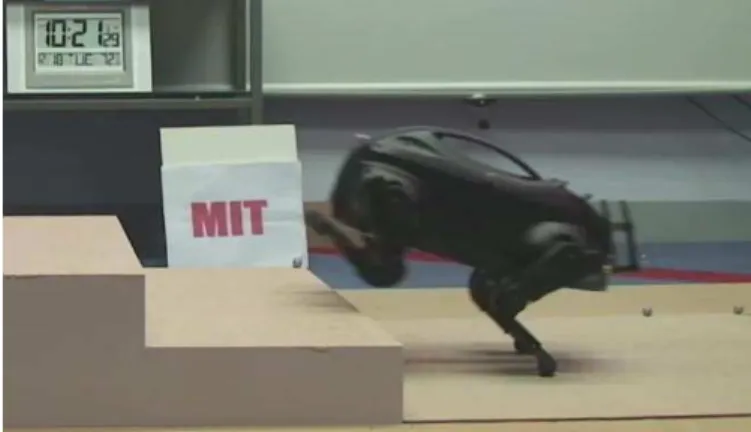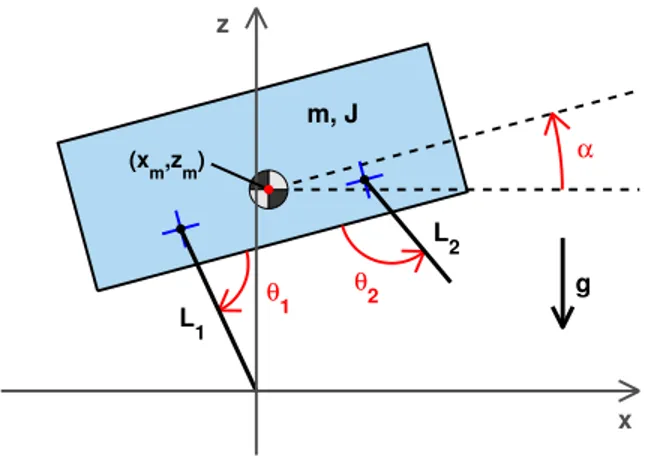Dynamically diverse legged locomotion for rough terrain
The MIT Faculty has made this article openly available.
Please share
how this access benefits you. Your story matters.
Citation
Byl, Katie, and Russ Tedrake. “Dynamically Diverse Legged
Locomotion for Rough Terrain.” Proceedings of the 2009 IEEE
International Conference on Robotics and Automation, Kobe
International Conference Center, Kobe, Japan, May 12-17, 2009
1607-1608. © Copyright 2009 IEEE.
As Published
http://dx.doi.org/10.1109/ROBOT.2009.5152757
Publisher
Institute of Electrical and Electronics Engineers
Version
Final published version
Citable link
http://hdl.handle.net/1721.1/64752
Terms of Use
Article is made available in accordance with the publisher's
policy and may be subject to US copyright law. Please refer to the
publisher's site for terms of use.
Dynamically Diverse Legged Locomotion for Rough Terrain
Katie Byl and Russ Tedrake
Abstract— In this video, we demonstrate the effectiveness of a kinodynamic planning strategy that allows a high-impedance quadruped to operate across a variety of rough terrain. At one extreme, the robot can achieve precise foothold selection on intermittent terrain. More surprisingly, the same inherently-stiff robot can also execute highly dynamic and underactuated motions with high repeatability. This range of dynamic mo-tion is possible through careful reasoning about the coupled dynamics during underactuated phases of motion. Our results demonstrate visceral progress toward realization of one of the central theoretically claims giving legged locomotion a “leg-up” over wheeled robotics: that appropriate design of control can produce a set of capabilities which span a dynamic range from deliberate foothold selection through acrobatic-style motion on a single, particular robot.
I. INTRODUCTION
A goal for legged robots is an adaptability to terrain comparable to that legged creatures in nature: ideally, legged locomotion should exploit both careful foot placement and more dynamic motions, as appropriate to the terrain. How-ever, achieving both simultaneously in a single robot is a challenging task. While animals walk and run over incred-ible terrain with apparent ease [7], often leaping from one foothold to the next, many of our robots move slowly and methodically, constrained by overly restrictive measures of dynamic stability. As described by [5], what we strive toward as roboticists are “dynamically dextrous robots”.
The amazing dynamic capabilities of biological systems are often attributed to their use of compliant joints, which permit energy storage (and fast release) and provide a level of mechanical robustness. The mechanical design of low-impedance walking robots is one important approach toward achieving dynamic gaits [9]. By contrast, our work here explores solutions involving only control. In particular, we develop a motion-planning algorithm which allows a stiff, position-controlled quadruped robot to execute reliable dynamic maneuvers that are often associated with more compliant systems. By reasoning about the ground reaction forces and the dynamics of the passive degrees-of-freedom between the feet and the ground, we are able to design trajectories of the center of mass which maneuver the robot into and through a “bipedal” double-support phase.
Robots with exceptional capabilities on stochastically rough terrain, such as RHex [1], are typically incapable of careful foothold selection. By contrast, implementations
K. Byl is a postdoctoral fellow at the Harvard Microrobotics Laboratory, 60 Oxford St., Cambridge, MA 02138, USA
katiebyl@alum.mit.edu
R. Tedrake is an Assistant Professor of EECS at the Computer Science and Artificial Intelligence Lab, MIT, 32 Vassar St., Cambridge, MA 02139, USArusst@mit.edu
which aim toward precise foot placement often traverse terrain by using relatively slow, deliberate gaits [3], [4], [10], [8], [6]. In this video we demonstrate a control approach which can achieve both precise foot placement, as illustrated in Figure 1, and highly dynamic and fast motions, such as the lunge shown in Figure 2.
Fig. 1. LittleDog demonstrates careful foot placement.
Fig. 2. LittleDog exploits underactuated, dynamic motions to climb a step.
II. EXPERIMENTALHARDWARE
The LittleDog quadruped has an approximate mass of 2.4 kg and 18 degrees of freedom (DOF): 12 actuated leg joints, plus the 6 (underactuated) degrees of freedom of body. Planning for desired joint trajectories is done on an off-board computer; a low-level PD control loop onboard the robot regulates the joints. Joint commands are actuated through high gear-ratio transmissions (84:1), giving them high impedance to external disturbances. Rounded feet on the dog allow for no achievable ankle torque, so the support legs become unactuated during double-support motions.
2009 IEEE International Conference on Robotics and Automation Kobe International Conference Center
Kobe, Japan, May 12-17, 2009
The robot operates in a motion capture (mocap) envi-ronment, to estimate the 6 DOF of the body and to detect upcoming, scanned terrain boards.
III. METHODS
When precise footholds are require, as in Figure 1, we plan statically stable poses for the robot and execute them slowly. Underactuated motions such as the dynamic lunge in Figure 2 are planned using low-dimensional, planar models, as depicted in Figure 3. The two components of force (in x and z, only) generate both two corresponding translational accelerations and a rotational acceleration. To produce fea-sible and repeatable kinodynamic plans, we reason about the physically achievable joint velocities, the ground reaction forces, and the inherent effects of stochasticity on the dynam-ics. Our results demonstrate low variability in the peak angle achieved during a lunge. In crossing a gap, for example, the peak pitch angle of the robot has a mean of 24.6◦ with a
standard deviation of less than one degree.
L1 L2 m, J α θ 1 θ 2 x z g (x m,zm)
Fig. 3. Planar model of the robot during a dynamic lunge.
IV. CONCLUSIONS
In the accompanying video, we demonstrate a range of dynamic behaviors for a particular legged robot. At one ex-treme, careful motions of the high-impedance robot allow for precise foothold selection. To achieve faster locomotion on
appropriate terrain with high reliability, we reason about the inertial coupling between actuated and unactuated degrees of freedom during phases of underactuation. Some of the results demonstrated here are discussed in more detail in [2].
V. ACKNOWLEDGMENTS
Our work on dynamic motions for LittleDog owes much to the entire MIT Team in the Learning Locomotion project. Particular recognition is given to Alec Shkolnik and Sam Prentice, who have made heroic contributions in developing code for autonomous control of LittleDog throughout Phase 2 of the project.
The authors gratefully acknowledge the support of the DARPA Learning Locomotion project (AFRL contract #FA8650-05-C-7262). The LittleDog robot is made by Boston Dynamics, of Waltham, Massachusetts, USA.
REFERENCES
[1] R. Altendorfer, N. Moore, H. Komsuoglu, M. Buehler, H.B. Brown Jr., D. McMordie, U. Saranli, R. Full, and D.E. Koditschek. RHex: A biologically inspired hexapod runner. Autonomous Robots, 11(3):207– 213, Nov 2001.
[2] Katie Byl, Alec Shkolnik, Sam Prentice, Nick Roy, and Russ Tedrake. Reliable dynamic motions for a stiff quadruped. In Proceedings of the 11th International Symposium on Experimental Robotics (ISER), 2008.
[3] Elena Garcia and Pablo Gonzalez de Santos. An improved energy stability margin for walking machines subject to dynamic effects. Robotica, 23:13–20, 2005.
[4] Shigeo Hirose and Keisuke Kato. Study on quadruped walking robot in tokyo institute of technology. In Proceedings of the 2000 IEEE International Conference on Robotics and Automation, pages 414– 419. IEEE, April 2000.
[5] Daniel E. Koditschek and Martin Buehler. Analysis of a simplified hopping robot. International Journal of Robotics Research, 10(6):587– 605, Dec 1991.
[6] J. Zico Kolter, Mike P. Rodgers, and Andrew Y. Ng. A control archi-tecture for quadruped locomotion over rough terrain. In Proceedings of the IEEE International Conference on Robotics and Automation (ICRA), pages 811–818, 2008.
[7] Thomas A. McMahon. Muscles, Reflexes, and Locomotion. Princeton University Press, May 1984.
[8] Dimitris Pongas, Michael Mistry, and Stefan Schaal. A robust quadruped walking gait for traversing rough terrain. ICRA2007, 2007.
[9] Gill A. Pratt. Low impedance walking robots. Integ. and Comp. Biol., 42:174–181, 2002.
[10] John Rebula, Peter Neuhaus, Brian Bonnlander, Matthew Johnson, and Jerry Pratt. A controller for the littledog quadruped walking on rough terrain. Proceedings of the 2007 IEEE International Conference on Robotics and Automation (ICRA), Rome, Italy, 2007.

